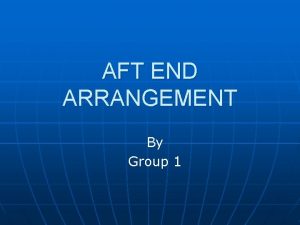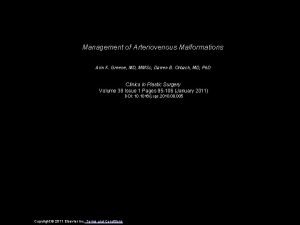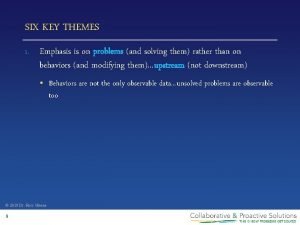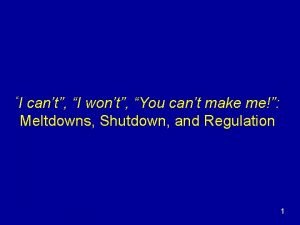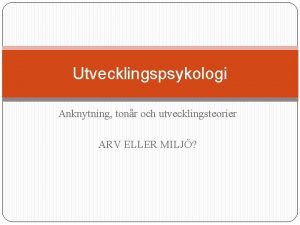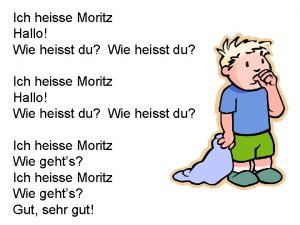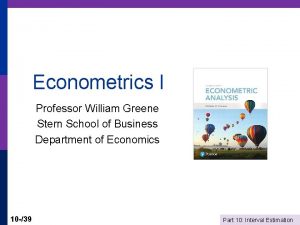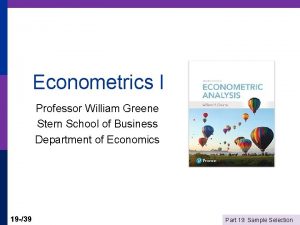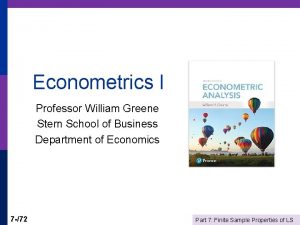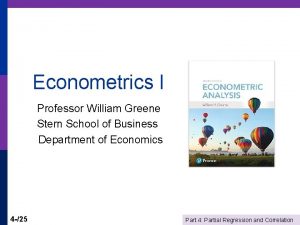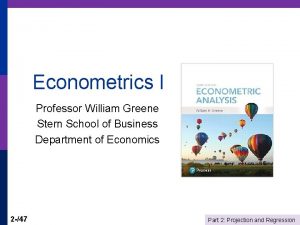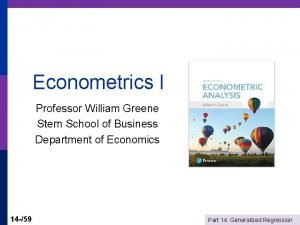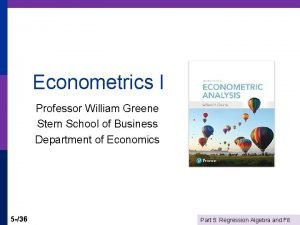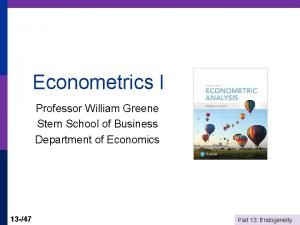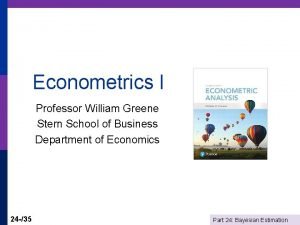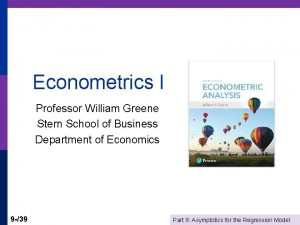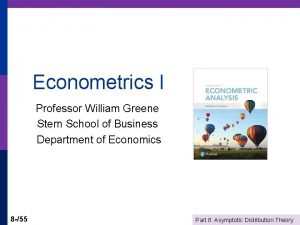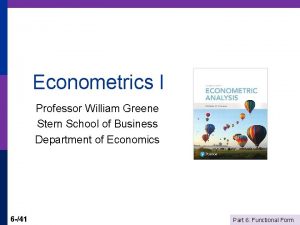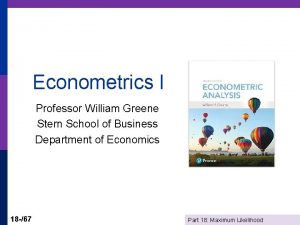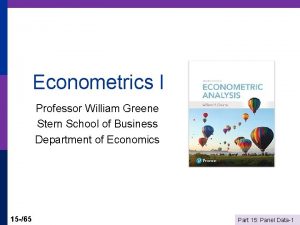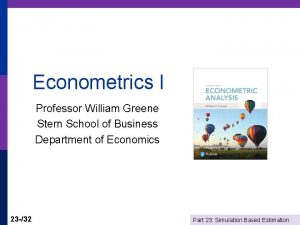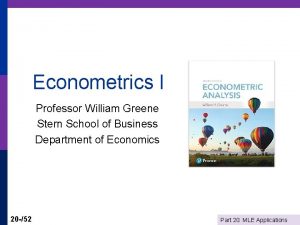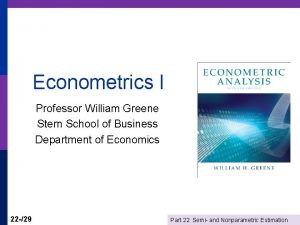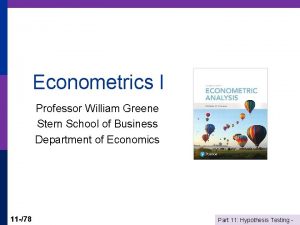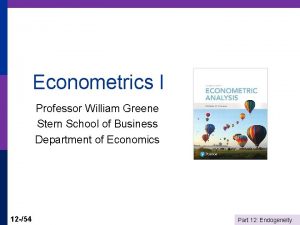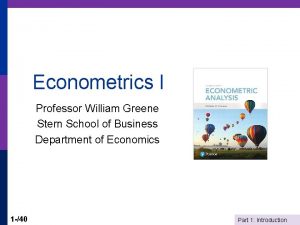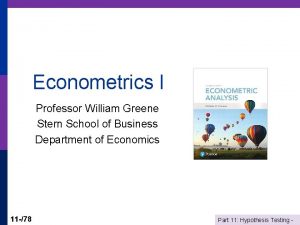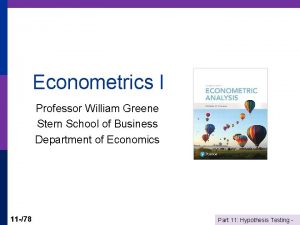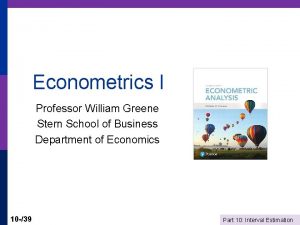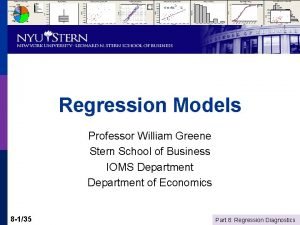Econometrics I Professor William Greene Stern School of




![An Analogy Principle for Estimating In the population E[y | X ] = X An Analogy Principle for Estimating In the population E[y | X ] = X](https://slidetodoc.com/presentation_image_h/dcfde5d6790e606cfac6e0cca23b4495/image-5.jpg)
![Population Moments We assumed that E[ i|xi] = 0. (Slide 2: 40) It follows Population Moments We assumed that E[ i|xi] = 0. (Slide 2: 40) It follows](https://slidetodoc.com/presentation_image_h/dcfde5d6790e606cfac6e0cca23b4495/image-6.jpg)























- Slides: 29

Econometrics I Professor William Greene Stern School of Business Department of Economics 3 -/29 Part 3: Least Squares Algebra

Econometrics I Part 3 – Least Squares Algebra 3 -/29 Part 3: Least Squares Algebra

Vocabulary p p p 3 -3/29 Some terms to be used in the discussion. n Population characteristics and entities vs. sample quantities and analogs n Residuals and disturbances n Population regression line and sample regression Objective: Learn about the conditional mean function. ‘Estimate’ and 2 First step: Mechanics of fitting a line (hyperplane) to a set of data Part 3: Least Squares Algebra

Fitting Criteria p p p The set of points in the sample Fitting criteria - what are they: n LAD: Minimizeb |y – x’b. LAD| n Least squares: Minimizeb (y – x’b. LS)2 n and so on Why least squares? A fundamental result: Sample moments are “good” estimators of their population counterparts We will examine this principle and apply it to least squares computation. 3 -4/29 Part 3: Least Squares Algebra
![An Analogy Principle for Estimating In the population Ey X X An Analogy Principle for Estimating In the population E[y | X ] = X](https://slidetodoc.com/presentation_image_h/dcfde5d6790e606cfac6e0cca23b4495/image-5.jpg)
An Analogy Principle for Estimating In the population E[y | X ] = X so E[y - X |X] = 0 Continuing (assumed) E[xi i] = 0 for every i Summing, Σi E[xi i] = Σi 0 = 0 Exchange Σi and E[] E[Σi xi i] = E[ X ] = 0 E[X (y - X ) ] = 0 So, if X is the conditional mean, then E[X’ ] = 0. We choose b, the estimator of , to mimic this population result: i. e. , mimic the population mean with the sample mean Find b such that As we will see, the solution is the least squares coefficient vector. 3 -5/29 Part 3: Least Squares Algebra
![Population Moments We assumed that E ixi 0 Slide 2 40 It follows Population Moments We assumed that E[ i|xi] = 0. (Slide 2: 40) It follows](https://slidetodoc.com/presentation_image_h/dcfde5d6790e606cfac6e0cca23b4495/image-6.jpg)
Population Moments We assumed that E[ i|xi] = 0. (Slide 2: 40) It follows that Cov[xi, i] = 0. Proof: Cov(xi, i) = Cov(xi, E[ i |xi]) = Cov(xi, 0) = 0. (Theorem B. 2). If E[yi|xi] = xi’ , then = (Var[xi])-1 Cov[xi, yi]. Proof: Cov[xi, yi] = Cov[xi, E[yi|xi]]=Cov[xi, xi’ ] This will provide a population analog to the statistics we compute with the data. 3 -6/29 Part 3: Least Squares Algebra

U. S. Gasoline Market, 1960 -1995 3 -7/29 Part 3: Least Squares Algebra

Least Squares p Example will be, Gi regressed on xi = [1, PGi , Yi] p Fitting criterion: Fitted equation will be yi = b 1 xi 1 + b 2 xi 2 +. . . + b. Kxi. K. p Criterion is based on residuals: ei = yi - b 1 xi 1 + b 2 xi 2 +. . . + b. Kxi. K Make ei as small as possible. Form a criterion and minimize it. 3 -8/29 Part 3: Least Squares Algebra

Fitting Criteria p Sum of residuals: p Sum of squares: p Sum of absolute values of residuals: p Absolute value of sum of residuals p We focus on 3 -9/29 now and later Part 3: Least Squares Algebra

Least Squares Algebra 3 -10/29 Part 3: Least Squares Algebra

Least Squares Normal Equations 3 -11/29 Part 3: Least Squares Algebra

Least Squares Normal Equations 3 -12/29 Part 3: Least Squares Algebra

Least Squares Solution 3 -13/29 Part 3: Least Squares Algebra

Second Order Conditions 3 -14/29 Part 3: Least Squares Algebra

Side Result: Sample Moments 3 -15/29 Part 3: Least Squares Algebra

Does b Minimize e’e? 3 -16/29 Part 3: Least Squares Algebra

A Positive Definite Matrix 3 -17/29 Part 3: Least Squares Algebra

Algebraic Results - 1 3 -18/29 Part 3: Least Squares Algebra

Residuals vs. Disturbances 3 -19/29 Part 3: Least Squares Algebra

Algebraic Results - 2 p p p p 3 -20/29 A “residual maker” M = (I - X(X’X)-1 X’) e = y - Xb= y - X(X’X)-1 X’y = My My = The residuals that result when y is regressed on X MX = 0 (This result is fundamental!) How do we interpret this result in terms of residuals? When a column of X is regressed on all of X, we get a perfect fit and zero residuals. (Therefore) My = MXb + Me = e (You should be able to prove this. y = Py + My, P = X(X’X)-1 X’ = (I - M). PM = MP = 0. Py is the projection of y into the column space of X. Part 3: Least Squares Algebra

The M Matrix M = I- X(X’X)-1 X’ is an nxn matrix p M is symmetric – M = M’ p M is idempotent – M*M = M (just multiply it out) p M is singular; M-1 does not exist. (We will prove this later as a side result in another derivation. ) p 3 -21/29 Part 3: Least Squares Algebra

Results when X Contains a Constant Term p p p X = [1, x 2, …, x. K] The first column of X is a column of ones Since X’e = 0, x 1’e = 0 – the residuals sum to zero. 3 -22/29 Part 3: Least Squares Algebra

U. S. Gasoline Market, 1960 -1995 3 -23/29 Part 3: Least Squares Algebra

Least Squares Algebra 3 -24/29 Part 3: Least Squares Algebra

Least Squares 3 -25/29 Part 3: Least Squares Algebra

Residuals 3 -26/29 Part 3: Least Squares Algebra

Least Squares Residuals (autocorrelated) 3 -27/29 Part 3: Least Squares Algebra

Least Squares Algebra-3 M is n n potentially huge 3 -28/29 Part 3: Least Squares Algebra

Least Squares Algebra-4 MX = 3 -29/29 Part 3: Least Squares Algebra
 Aft end construction of ship
Aft end construction of ship Promotion from assistant to associate professor
Promotion from assistant to associate professor Kylie greene
Kylie greene The tenth man graham greene summary
The tenth man graham greene summary Green's theorem is a special case of
Green's theorem is a special case of The destructors graham greene
The destructors graham greene Linda r greene
Linda r greene Journey without maps
Journey without maps Robert greene shakespeare
Robert greene shakespeare Arin greene
Arin greene Linda r greene
Linda r greene Alsup ross greene
Alsup ross greene Collaborative problem solving plan a b c
Collaborative problem solving plan a b c Maxine greene releasing the imagination
Maxine greene releasing the imagination Ericka simpson md
Ericka simpson md Eric greene course
Eric greene course Charismatic conversation secrets
Charismatic conversation secrets Uzuri pease-greene
Uzuri pease-greene Citl ucsc
Citl ucsc Människans åtta åldrar
Människans åtta åldrar Stern village trumbull ct
Stern village trumbull ct Sea transport solutions stern landing vessel
Sea transport solutions stern landing vessel Dr theodore stern
Dr theodore stern Strong iron post on a ship deck for working fastening lines
Strong iron post on a ship deck for working fastening lines Experimento de stern-gerlach
Experimento de stern-gerlach Bow stern port starboard
Bow stern port starboard Dr brian stern
Dr brian stern Hallo wie heisst du
Hallo wie heisst du Ady stern
Ady stern Daniel stern model
Daniel stern model
